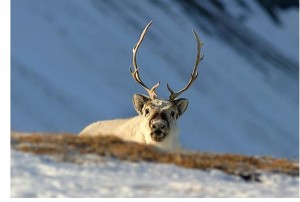THURSDAY, 2 JUNE 2011
 It’s grim up north, especially in winter: snow is everywhere, food is scarce and predators are many. Daylight is in short supply, and what little there is scatters in such a way that there is much more blue and ultraviolet light than usual. The snow compounds the problem, reflecting up to 90% of the UV light that falls on it. So much UV can cause temporary blindness in humans, making us vulnerable to predators and starvation.
It’s grim up north, especially in winter: snow is everywhere, food is scarce and predators are many. Daylight is in short supply, and what little there is scatters in such a way that there is much more blue and ultraviolet light than usual. The snow compounds the problem, reflecting up to 90% of the UV light that falls on it. So much UV can cause temporary blindness in humans, making us vulnerable to predators and starvation.However, according to research published in the latest issue of Journal of Experimental Biology, reindeer have turned these high levels of UV to their advantage [1]. Using the electrical response of the retina to confirm the animal’s sensitivity to light at different wavelengths, Professor Glen Jeffery and his team from University College London found that light with wavelengths down to 320 nm can pass through a reindeer’s lens and cornea. The visible range for humans is 700-400 nm; UV is 10-400 nm.
Using special cameras, the team identified several key substances that would appear black to reindeer because they absorb UV light. Among these are fur, signifying predators such as wolves; urine, a territorial marker, and lichen, an important source of food. This heightened visual ability is such an advantage that Jeffery suspects most arctic animals have made the same adaptation, and his team now plan to perform the same tests on seals [2].
Written by Jo Smith
References:
- Arctic reindeer extend their visual range into the ultraviolet. 2011. Hogg, C., Neveu, M., Stokkan, K.-A., Folkow, L., Cottrill, P., Douglas, R., Hunt, D.M. & Jeffery, G. Journal of Experimental Biology 214:2014-2019. doi:10.1242/jeb.053553
- http://www.sciencedaily.com/releases/2011/05/110526064627.htm
